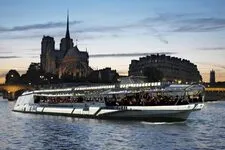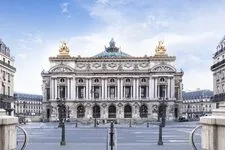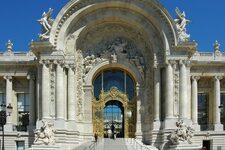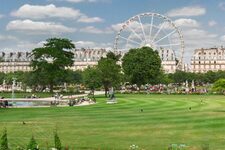Everything you need to know about the Grand Palais in Paris!
A symbol of Parisian architectural elegance, the Grand Palais is an unmissable monument of the capital. Located in the heart of Paris, between the Champs-Élysées and the Seine, it hosts prestigious exhibitions, renowned fairs, and large-scale cultural events every year.
After several years of major renovation, the Grand Palais finally reopened its doors in 2024, offering visitors a renewed and immersive experience. Its impressive glass roof, vast spaces, and central role in the Paris 2024 Olympic Games make it one of the most anticipated sites of the year.
In this article, discover the fascinating history of the Grand Palais, the exhibitions and events planned for 2025, as well as all the practical information to prepare your visit.

History of the Grand Palais
Built to celebrate the World's Fair of 1900, the Grand Palais was designed as a true architectural masterpiece combining stone, glass, and steel. Its immense glass roof, one of the largest in the world, quickly became a technical and artistic feat.
A monumental work of the World's Fair of 1900
In 1896, a competition open to all architects in the country was launched: the one with the best ideas regarding the plans for the future Grand Palais would be entrusted with the prestigious task of overseeing its construction. After multiple fiercely contested trials and lively debates among the members of the "jury," the press, and the general public, architects Henri Deglane, Albert Louvet, Albert-Félix-Théophile Thomas, and Charles Girault could not ultimately be separated and were all four chosen. They then synthesized their respective proposals and collaborated to build the monument. On the pediment of the west wing, it can be read that the monument is "dedicated by the Republic to the glory of French art." The primary purpose of the place is thus to host the greatest official artistic events of the capital.
The Grand Palais is one of the pieces of a vast architectural ensemble consisting of the Alexander III Bridge, Winston Churchill Avenue - which connects the Invalides to the Champs-Elysées - the Grand and the Petit Palais. By installing the Grand Palais in the heart of the presidential district, the Third Republic sends a strong message: the building alone illustrates the intellectual and cultural radiance of France. From 1901, the Grand Palais hosts the largest artistic salons and many other sporting and social events. It is notably for the equestrian competition, organized in the Grand Palais from 1901, that the monument is equipped with a nave and a sanded track. From April 1901 to 1957, the equestrian competition, with carriage competitions, speed trials, and show jumping, is a highly anticipated moment in Parisian life.
From elitist salons to popular events
The salons dedicated to fine arts reach their peak and experience very high attendance during the first thirty years of the palace's opening. However, these events are considered by many as an expression of a growing gap between the bourgeois elites and the "general public," who are denied access to art. After World War I, Parisians turn more towards technical and commercial salons that are more profitable. Parisian artistic and elitist events gradually lose their prestige and see their spaces significantly reduced with the inauguration of the Palais de la Découverte in 1937 during the World Expo.
The Palais de la Découverte is located in the west wing of the Grand Palais and was originally designed as a presentation of temporary exhibitions. However, it becomes a hit with visitors to such an extent that it is decided not to dismantle it, but to make it a permanent scientific cultural center. In 1947, the Grand Palais completely loses its original function as the Palace of Fine Arts.
Today, the Grand Palais welcomes more than 2 million visitors and 40 events each year.
The renovation of the Grand Palais (2021-2024)
In the face of challenges posed by time and evolving safety standards, the Grand Palais began an ambitious renovation in 2021 aimed at modernizing its infrastructure while preserving its historical heritage.
The main objectives of this renovation:
- Restore the glass roof to optimize natural light.
- Improve accessibility for all visitors.
- Strengthen the structure to host world-class events.
During this period, the events of the Grand Palais were temporarily moved to the Grand Palais Éphémère, a provisional structure set up on the Champ-de-Mars.
In 2024, after three years of work, the Grand Palais finally reopened its doors, ready to welcome visitors and the most prestigious events once again.
What to see at the Grand Palais in 2025?
After its reopening in 2024, the Grand Palais has become a major player in the Parisian cultural scene. In 2025, it offers an exceptional program combining immersive exhibitions, artistic events, and must-see appointments.
Key exhibitions and events
Here are the upcoming exhibitions and events in 2025!
Grand Palais Immersive: a journey into the digital
The Grand Palais Immersive continues to surprise in 2025 with stunning interactive and visual experiences. This year's flagship exhibition, "PIXELS" by Miguel Chevalier, immerses visitors in a universe where artificial intelligence and digital art merge to create dynamic and evolving works.
Art Basel Paris 2025: the contemporary art meeting
One of the highlights of the year remains the 2025 edition of Art Basel Paris, which brings together the greatest collectors and artists from around the world. With galleries from all corners of the globe, this event is an absolute reference for contemporary art enthusiasts and professionals.
A unique exhibition on Dolce & Gabbana
The Grand Palais also hosts a unique retrospective on Dolce & Gabbana, exploring the influence of Italian culture on fashion and luxury. This exhibition highlights the iconic pieces of the fashion house, accompanied by projections and immersive staging.
Major cultural and sporting events
In addition to the exhibitions, the Grand Palais becomes in 2025 a hub of sport and entertainment with:
- The major Parisian fairs such as the International Contemporary Art Fair (FIAC).
- Unique artistic performances and shows, blending theater, dance, and visual installations.
To complete your visit, a stroll to the Pont Alexandre III allows you to admire one of the most beautiful views of the Seine, just a few steps from the Grand Palais.
Practical information: access, hours, prices
In this section, you will find all the information and access conditions for the Grand Palais.
How to get to the Grand Palais?
The Grand Palais is located Avenue Winston-Churchill, in the 8th arrondissement of Paris, in the heart of the Champs-Élysées district. It is easily accessible by several means of transport:
- Metro: Line 1 and 13 (Champs-Élysées – Clemenceau) / Line 9 (Franklin D. Roosevelt).
- Bus: Lines 28, 42, 73, 83, 93 (stop Grand Palais).
- Bike: Vélib' stations nearby.
- Car: Public parking available in the vicinity.
Hours and prices
In 2025, the hours of the Grand Palais vary depending on exhibitions and events. It is advisable to check the official website for the specific hours of ongoing exhibitions.
General hours:
- From Tuesday to Sunday: 10 AM – 7 PM
- Late openings on certain days until 10 PM
- Closed on Monday
Prices 2025:
- Full price: 15 to 20 € depending on the exhibitions
- Reduced price: 10 to 15 € (students, seniors, job seekers)
- Free for children under 6 years old
Book your tickets online
To avoid queues and benefit from quick access, it is recommended to purchase your tickets online. Several options are available:
- Skip-the-line tickets available through official platforms.
- Combined passes to explore multiple exhibitions.
- Advance reservations for high-attendance events.
Visitors wishing to extend their walk can reach the Tuileries Garden in a few minutes, an ideal place to relax after a visit to the Grand Palais.
Good addresses near the Grand Palais
A visit to the Grand Palais is often an opportunity to explore the surroundings and discover some of the best addresses in Paris. Whether for a gourmet meal, a coffee break, or a cultural stroll, here are some must-visit suggestions in 2025.
Where to eat around the Grand Palais?
Gourmet restaurants
- Lasserre – A Parisian institution, offering refined French cuisine in an elegant setting.
- Le Clarence – A starred restaurant located in a private mansion in the 8th arrondissement.
Typical bistros and brasseries
- Le Mini Palais – Located inside the Grand Palais, this restaurant offers modern French cuisine with a pleasant terrace.
- Brasserie Thoumieux – A chic bistro offering classic dishes reinterpreted with finesse.
Cafés and tea rooms
- Carette – Ideal for a gourmet break with its pastries and hot chocolate.
- Ladurée Champs-Élysées – Perfect for tea accompanied by iconic macarons.
What to visit nearby?
After your visit to the Grand Palais, several points of interest are just a few minutes' walk away:
- Le Petit Palais – Located right across, it houses the Museum of Fine Arts of the City of Paris, with free exhibitions.
- Les Champs-Élysées – Just a short walk away, this legendary avenue is filled with luxury shops, theaters, and restaurants.
- Les Invalides – A 10-minute walk, this iconic Paris monument houses Napoleon's tomb and the Army Museum. Discover the fascinating history of the Invalides and its impressive architecture.
Activities in the Surroundings

Bateaux Mouches Dinner Cruise in Paris

Palais Garnier

Petit Palais
FAQ: answers to frequently asked questions
Why was the Grand Palais renovated?
The renovation of the Grand Palais (2021-2024) aimed to modernize the infrastructure, improve accessibility, and strengthen the building's structure while preserving its historical heritage.
How long does it take to visit the Grand Palais?
The average duration of a visit depends on the chosen exhibition. Plan for about 1.5 to 2 hours for a temporary exhibition and more if you wish to explore several areas of the monument.
What is the best time to visit the Grand Palais?
The Grand Palais is open all year round, but the ideal times are spring and autumn, when attendance is more moderate. However, major exhibitions attract many visitors, so it is recommended to book tickets in advance.
Can you visit the Grand Palais with children?
Yes, the Grand Palais offers exhibitions suitable for families and educational tours for younger visitors. Some immersive exhibitions, such as those at the Grand Palais Immersif, are particularly suitable for children.



